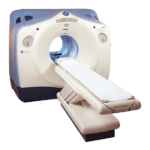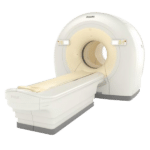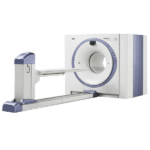Reforming access to Alzheimer’s treatments: The focus on beta amyloid positron emission tomography
(Positron Emission Tomography / Computed Tomography) PET/CT scanners
What’s Changing?
In a transformative move, the Centers for Medicare & Medicaid Services (CMS) have eliminated the National Coverage Determination (NCD), which previously served as a barrier, limiting access to novel Alzheimer’s medications. This pivotal change in healthcare policy signifies a monumental shift in access to Alzheimer’s treatments, offering renewed hope for individuals affected by the disease. By eliminating NCD limitations, CMS has empowered healthcare providers and overhauled the decision-making process, transferring the authority for coverage determinations to regional Medicare Administrative Contractors (MACs). This shift marks a significant step towards granting healthcare providers the autonomy to independently assess and evaluate patients for the treatments they require, thus personalizing healthcare delivery to a higher degree.
This transformation’s core facet is the newfound capability of regional MACs to make their own determinations regarding the coverage of PET Beta Amyloid Imaging. This power shift is guided by the criteria outlined in section 1862(a)(1)(A) of the Social Security Act. Under this criterion, the healthcare providers entrusted with the welfare of their patients can now make nuanced decisions to assess whether PET Beta Amyloid Imaging is indeed “reasonable and necessary” for diagnosis or treatment. This landmark change ensures that healthcare decisions are more patient-centric, offering an opportunity for tailored and more responsive healthcare, particularly for those exhibiting Alzheimer’s symptoms. This significant development not only expands access to Alzheimer’s treatments but also magnifies the role of Amyloid PET Scans as a diagnostic tool that can provide early intervention and better management of the disease.
Understanding Amyloid Positron Emission Tomography (PET)
Amyloid Positron Emission Tomography (PET) is a non-invasive neuroimaging technique that has revolutionized the field of Alzheimer’s diagnostics. Its primary function is to enable the visualization of the deposition of fibrillar amyloid-beta in the living human brain, a pivotal feature in Alzheimer’s disease pathology. Amyloid PET, as a cutting-edge diagnostic tool, plays a vital role not only in enhancing diagnostic accuracy in clinical practice and research studies but also in expanding the pool of eligible participants for clinical trials of disease-modifying drugs, particularly those targeting the early stages of Alzheimer’s disease.
The methodology behind Amyloid PET imaging is rooted in the use of a radioisotope-labeled ligand that binds selectively to the fibrillar amyloid-beta protein in the brain. This ligand, often referred to as a “tracer,” is administered to the patient and undergoes a process of decay, emitting positrons. These emitted positrons are captured by a specialized positron camera, or tomograph, which records the decay process of the tracers within the human brain. This imaging technique facilitates the assessment of relative variations in the rate of tracer decay across different anatomical sites within the brain, offering invaluable biochemical insights into the tissue under examination.
Get Started
Request Pricing Today!
We’re here to help! Simply fill out the form to tell us a bit about your project. We’ll contact you to set up a conversation so we can discuss how we can best meet your needs. Thank you for considering us!
Great support & services
Save time and energy
Peace of mind
Risk reduction
Amyloid PET imaging doesn’t stop at diagnostics. It extends its influence to enriching the pool of participants for clinical trials of disease-modifying drugs, especially in the early stages of Alzheimer’s disease. Furthermore, when combined with the emerging tau imaging method, Amyloid PET holds the promise of unveiling intricate details of the early pathophysiological mechanisms that underlie Alzheimer’s disease. This heightened understanding of the disease’s underlying processes may be the catalyst for the development of effective disease-modifying therapies and innovative prevention strategies.
Amyloid negativity, a significant outcome of Amyloid PET scans, emerges as an invaluable marker when it comes to the differential diagnosis of dementia conditions. It plays a pivotal role in excluding the possibility of Alzheimer’s disease, allowing for more precise diagnosis and healthcare decisions. Beyond Alzheimer’s, Amyloid imaging is an essential tool in clinical studies and trials addressing a broad spectrum of dementia disorders, encompassing conditions such as frontotemporal lobar degeneration, argyrophilic grain disease, and neurofibrillary tangle-dominant diseases.
As the medical field progresses, this change promises to offer a more comprehensive understanding of non-Alzheimer’s dementias. This evolving diagnostic landscape brings us closer to unveiling the intricacies of neurological diseases, expanding the horizons of medical knowledge and advancing patient care.
In Conclusion
The elimination of NCD restrictions by CMS, coupled with the empowering shift of coverage determinations to regional MACs, marks a profound change in access to Alzheimer’s treatments. This transformation not only streamlines access for symptomatic individuals but also places a special emphasis on the pivotal role of Amyloid PET Scans as a diagnostic tool, fostering greater diagnostic precision and enabling more tailored care. The advent of Amyloid Positron Emission Tomography has ushered in a new era of non-invasive neuroimaging, offering a window into the intricacies of Alzheimer’s disease and other cognitive disorders. The amalgamation of Amyloid PET and emerging tau imaging techniques holds the potential to illuminate the early pathophysiological mechanisms underlying these conditions, fueling the development of effective disease-modifying therapies and innovative prevention strategies. Furthermore, as we delve deeper into the realm of dementia diagnosis, the reliability of amyloid negativity in differential diagnoses underscores the vital role of amyloid imaging in clinical studies and trials targeting a spectrum of dementia disorders. As we move forward, the pursuit of in vivo imaging techniques for visualizing tau and alpha-synuclein promises to expand our comprehension of non-Alzheimer’s dementias, ushering in an era of comprehensive care and understanding. This transformation marks a significant step towards personalizing healthcare and enhancing the quality of life for those battling Alzheimer’s and related disorders.
Sources
https://pubmed.ncbi.nlm.nih.gov/28739995/
https://www.cms.gov/medicare-coverage-database/view/ncacal-tracking-sheet.aspx?ncaid=308
https://www.cms.gov/medicare-coverage-database/view/ncacal-decision-memo.aspx?proposed=N&ncaid=308



